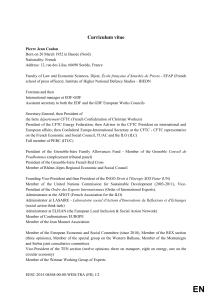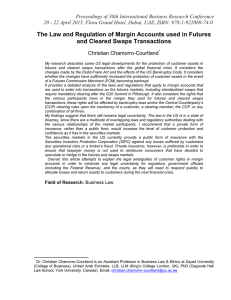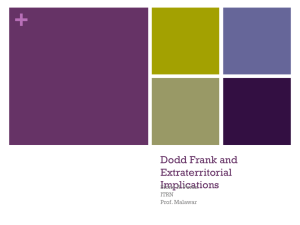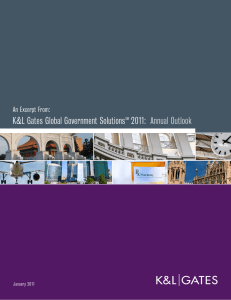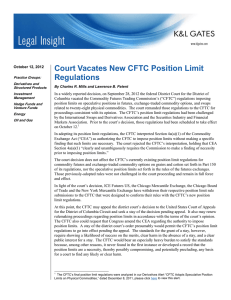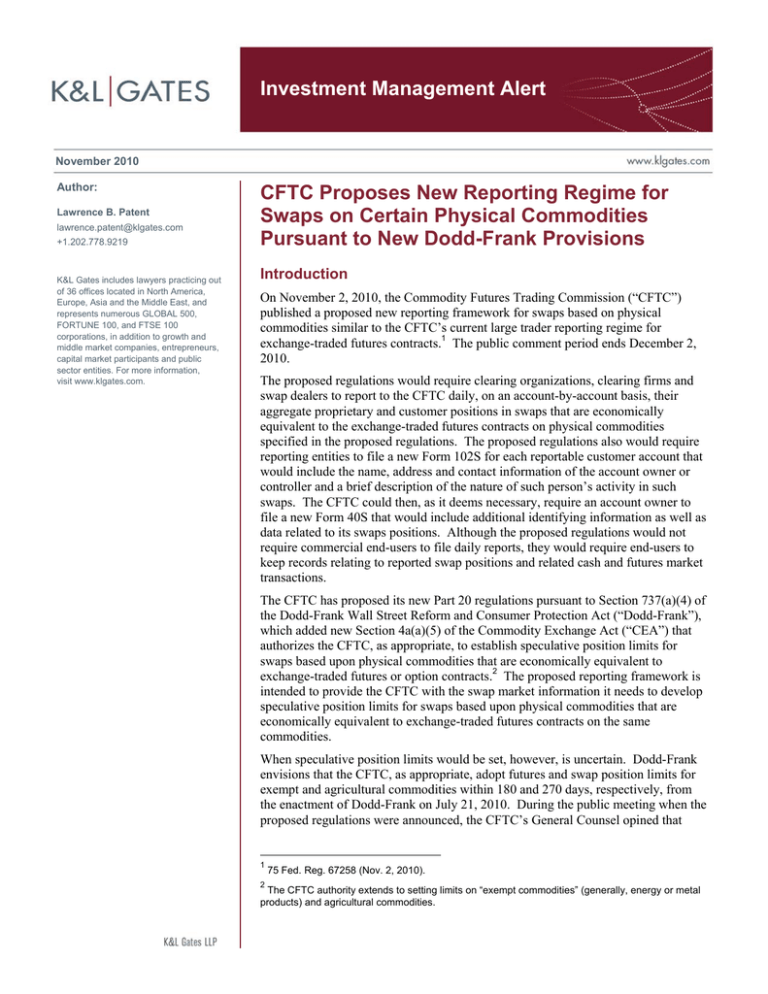
Investment Management Alert
November 2010
Author:
Lawrence B. Patent
lawrence.patent@klgates.com
+1.202.778.9219
K&L Gates includes lawyers practicing out
of 36 offices located in North America,
Europe, Asia and the Middle East, and
represents numerous GLOBAL 500,
FORTUNE 100, and FTSE 100
corporations, in addition to growth and
middle market companies, entrepreneurs,
capital market participants and public
sector entities. For more information,
visit www.klgates.com.
CFTC Proposes New Reporting Regime for
Swaps on Certain Physical Commodities
Pursuant to New Dodd-Frank Provisions
Introduction
On November 2, 2010, the Commodity Futures Trading Commission (“CFTC”)
published a proposed new reporting framework for swaps based on physical
commodities similar to the CFTC’s current large trader reporting regime for
exchange-traded futures contracts.1 The public comment period ends December 2,
2010.
The proposed regulations would require clearing organizations, clearing firms and
swap dealers to report to the CFTC daily, on an account-by-account basis, their
aggregate proprietary and customer positions in swaps that are economically
equivalent to the exchange-traded futures contracts on physical commodities
specified in the proposed regulations. The proposed regulations also would require
reporting entities to file a new Form 102S for each reportable customer account that
would include the name, address and contact information of the account owner or
controller and a brief description of the nature of such person’s activity in such
swaps. The CFTC could then, as it deems necessary, require an account owner to
file a new Form 40S that would include additional identifying information as well as
data related to its swaps positions. Although the proposed regulations would not
require commercial end-users to file daily reports, they would require end-users to
keep records relating to reported swap positions and related cash and futures market
transactions.
The CFTC has proposed its new Part 20 regulations pursuant to Section 737(a)(4) of
the Dodd-Frank Wall Street Reform and Consumer Protection Act (“Dodd-Frank”),
which added new Section 4a(a)(5) of the Commodity Exchange Act (“CEA”) that
authorizes the CFTC, as appropriate, to establish speculative position limits for
swaps based upon physical commodities that are economically equivalent to
exchange-traded futures or option contracts.2 The proposed reporting framework is
intended to provide the CFTC with the swap market information it needs to develop
speculative position limits for swaps based upon physical commodities that are
economically equivalent to exchange-traded futures contracts on the same
commodities.
When speculative position limits would be set, however, is uncertain. Dodd-Frank
envisions that the CFTC, as appropriate, adopt futures and swap position limits for
exempt and agricultural commodities within 180 and 270 days, respectively, from
the enactment of Dodd-Frank on July 21, 2010. During the public meeting when the
proposed regulations were announced, the CFTC’s General Counsel opined that
1
2
75 Fed. Reg. 67258 (Nov. 2, 2010).
The CFTC authority extends to setting limits on “exempt commodities” (generally, energy or metal
products) and agricultural commodities.
Investment Management Alert
Dodd-Frank required the CFTC only to set a formula
for position limits by the 180-day and 270-day
deadlines, without having to establish the actual
limits themselves. CFTC Commissioner Sommers,
in her concurring statement accompanying the
proposals, and in other public statements, has made
clear that “no position limit is appropriate if it is
imposed without the benefit of receiving and fully
analyzing complete data concerning the open
interest in each market,” which she believes cannot
occur prior to the end of 2011.
The Swaps Covered by the Proposed
Regulations
Proposed Regulation 20.1 denominates swaps that
are economically equivalent to the specified futures
contracts as “paired swaps” or “paired swaptions”3
(for ease of reference, collectively “swaps”). The
Regulation would define such a swap to be one that
is directly or indirectly linked (including being
partially or fully settled on, or priced at a differential
to) the price of: (1) any commodity futures contract
listed in proposed CFTC Regulation 20.2; or (2) the
same commodity for delivery at the same location,
or locations with substantially the same supply and
demand fundamentals, as that of a commodity
futures contract listed in proposed CFTC Regulation
20.2.
Proposed CFTC Regulation 20.2 lists 46 different
futures contracts. The CFTC has identified 32 of
these in “Category One,” which have high open
interest and notional value. The remaining 14
futures contracts for which reporting of paired swaps
is proposed to be required are referred to as
“Category Two.” The contracts in Category Two do
not have high levels of open interest or significant
notional values, but the CFTC believes, based on
discussion with various industry representatives, that
the “contracts may serve as the pricing basis of a
significant number of swap market transactions,
thereby warranting some measure of [CFTC]
scrutiny.” The CFTC refers to the list of contracts in
proposed Regulation 20.2 as non-exclusive and
preliminary, and stated that it may decide not to
propose position limits on some of the futures listed
3
A swaption would be defined as an option to enter into a
swap or a physical commodity option included in the definition
of swap under the CEA and any CFTC regulations adopted
thereunder.
in the proposed regulation or, alternatively, may
decide to propose limits on some futures not listed
in the proposed regulation. Given the demarcation
between the categories (based upon open interest
and notional value) and the specific types of futures
listed, however, it is reasonable to expect that, in
ultimately setting position limits, the CFTC would
initially focus upon the swaps linked to the
Category One futures contracts.
The Swap Reporting Level –
Determining the Futures Equivalency
of a Position in a Swap
The reporting level would be 50 or more futuresequivalent swaps or swaptions based on the same
commodity in any one futures equivalent month.
The CFTC’s Federal Register release stated that the
futures-equivalency method of accounting for swap
positions is necessary so that the CFTC can develop
and enforce aggregate position limits that would
cover both futures and swaps. The CFTC also
stated that it does not expect the process to be
unduly burdensome because the entities that enter
into the subject swaps already use futures
equivalency methodology to manage residual price
risk.
The futures equivalency of a paired swap for any
month is based upon the total notional quantity of
the swap, divided by the size of a single related
futures contract, and that amount is then multiplied
by a fraction whose numerator is the number of
days the swap is open when the next to expire future
of the paired contract is trading, and whose
denominator is the total number of days in the term
of the swap. This complicated formula is rendered a
little easier to follow by a detailed Appendix to the
proposed regulations. The definition of “reportable
position” under proposed Regulation 20.1 would
encompass positions in paired swaps held by the
reporting entity until the first day after which the
positions fell below the 50 futures equivalent
threshold. The CFTC stated in the Federal Register
notice that this is necessary to verify that a reporting
entity’s paired swap positions are no longer above
the threshold.
Reporting Entities
The persons required to report swap positions under
the proposed regulations include clearing
November 2010
2
Investment Management Alert
organizations and “reporting entities,” which would
be defined as clearing members and swap dealers.
The definition of reporting entity in proposed
Regulation 20.1 is intended to identify financial
firms that regularly make markets in swaps, as well
as divisions or subsidiaries of large commercial
swap market participants that provide risk
management services to other commercial entities in
the normal course of their business operations. The
proposed regulations are intended to require reports
from financial firms and not from commercial endusers with swaps activities of limited scope. The
proposed definition of reporting entity includes an
exemption from the definition of reporting entity for
entities that are not commonly known as swap
dealers. The CFTC stated that its proposed
definition of reporting entity “could provide
visibility into the majority of paired swaps trading
activity without burdening commercial entities that
may have less experience with compliance and
reporting requirements.” However, the CFTC also
specifically solicits comments on the proposed
reporting entity definition and whether requiring
reports only from these market participants will
provide the CFTC with sufficient market data.
Identifying Swap Account Owners and
Controllers
Under the CFTC’s current large trader reporting
system for futures and options, when an account first
reaches the reportable level, the futures commission
merchant carrying the account is required to file a
Form 102 with the CFTC. Upon receiving the Form
102, the CFTC may then make a special call to the
owner or holder of the account to file a Form 40,
which requires further identifying information.
Like the CFTC’s current large trader reporting
system, proposed Regulation 20.5 governing
position reports of swaps in physical commodities
would require that, once an account reaches the 50
futures equivalent contract level, the reporting entity
holding or carrying the account file with CFTC a
Form 102S identifying the owner or controller of the
reportable account. The Form 102S would be
required to be filed within three days of the day an
account becomes reportable or at such time as
instructed by CFTC upon special call. The CFTC
may then contact the swap counterparty directly and
request that the counterparty file a Form 40S to
provide further identifying information, at such time
and place as directed in the call. A Form 40S filing
would consist of the submission of a Form 40,
which is to be completed as if the references to
futures or options were references to paired swaps
or swaptions. If the swap counterparty were already
within the CFTC large trader reporting system
because it held reportable futures positions, and its
Form 40 had been filed recently, the CFTC may not
find it necessary to require that the counterparty also
file a Form 40S.
Daily Reports
Under the CFTC’s current large trader reporting
system for futures and options, after an account first
reaches the reportable level, the futures commission
merchant carrying the account is required to file
daily, machine-readable position reports as long as
the account remains at or above the reportable level.
The CFTC is proposing a similar system of daily
reports to be made by clearing organizations and
reporting entities under proposed Regulations 20.3,
20.4 and 20.7.
The CFTC is proposing to require daily reports of
paired swap positions from clearing organizations,
clearing members and swap dealers. Clearing
organizations would be required to report their
clearing members’ aggregate proprietary and
aggregate customer accounts for paired swap
positions. The clearing organization report would
be required to include the gross long and gross short
futures equivalent positions for paired swaps (if
swaptions are involved, the gross long and short
positions would be reported on a non-delta-adjusted
basis),4 by each cleared product and by each futures
equivalent month. This report would also be
required to include the “commodity reference
price,” which would be defined as the price series
used by the parties to the swap to determine
payments made, exchanged or accrued. If
swaptions were involved, the expiration date, put or
call indicator, and strike price would also be
required.
In addition, clearing organizations would be
required to report to the CFTC on a daily basis, for
4
“Delta” is the expected change in an option’s price given a
one-unit change in the price of the underlying futures contract.
For example, an option with a delta of 0.5 would change $.50
when the underlying futures contract price moves $1.00.
November 2010
3
Investment Management Alert
each futures equivalent month, the end of reporting
day settlement prices for each cleared product, and
deltas for every unique swaption put and call,
expiration date and strike price. The CFTC stated
that the proposed second daily report from clearing
organizations would provide the type of information
that is necessary to assign a weight to a trader’s
positions.
The CFTC is also proposing to require daily reports
from reporting entities, that is, clearing members and
swap dealers. Reportable positions would include,
once the reporting entity’s paired swaps position
meets or exceeds the 50 futures equivalent threshold,
all other paired swap positions held by the reporting
entity in the same commodity underlying the paired
futures contract. The reporting entities would
separately consolidate proprietary positions,
counterparty positions, and positions in controlled
accounts. The information in the reports would be
required to be grouped separately by swap or
swaption account, by futures equivalent month, by
cleared or uncleared contracts, by commodity
reference price, and by clearing organization, if
cleared. For swap positions, long and short
positions would be shown separately, and for
swaptions, long and short positions would be shown
both non-delta-adjusted and delta-adjusted (if
uncleared, the reporting entity must use
economically reasonable and analytically supported
deltas). Only cleared swaptions would need to be
grouped by put or call, expiration date, and strike
price.
As with existing large trader reports, the daily
reports would be required to contain certain formats
to make them machine-readable. In addition, the
proposals contain a “sunset” provision, whereby the
CFTC could issue an order finding that swap data
repositories are capable of processing position data
that would enable the CFTC to effectively surveil
paired swaps and swaptions and to set and enforce
aggregate position limits.
Recordkeeping
Although commercial end-users would not be
required to file daily reports under the proposed
regulations, proposed Regulation 20.6 would
impose significant recordkeeping requirements for
reported positions. This would include a
counterparty to a swap dealer, if the position
reached the 50 futures-equivalent threshold. The
records that would be required to be kept by
reporting entities and persons with reportable
positions would include all records for transactions
concerning all reportable positions, including
records in the cash commodity, its products and
byproducts, and all commercial activities hedged by
taking a position in the futures contracts listed in the
proposals or paired swaps and swaptions. The
records that would be required are similar to those
required of a large trader under the CFTC’s existing
large trader reporting system for futures and
options, so if a commercial firm is already a large
trader under the existing system, the type of records
that would be required related to paired swaps and
swaptions should be familiar.
Conclusion
Dodd-Frank envisions that it may be appropriate for
the CFTC to limit the size of any market
participant’s speculative position in particular swaps
on physical commodities. Because swaps were
largely unregulated prior to Dodd-Frank, the CFTC
currently has scant market data necessary to
determine whether such limits are appropriate and
the particulars of any such limits themselves. The
CFTC’s new proposed reporting regime for swaps
on particular physical commodities is intended to
provide the means for it to acquire such data.
November 2010
4
Investment Management Alert
Anchorage Austin Beijing Berlin Boston Charlotte Chicago Dallas Dubai Fort Worth Frankfurt Harrisburg Hong Kong London
Los Angeles Miami Moscow Newark New York Orange County Palo Alto Paris Pittsburgh Portland Raleigh Research Triangle Park
San Diego San Francisco Seattle Shanghai Singapore Spokane/Coeur d’Alene Taipei Tokyo Warsaw
Washington, D.C.
K&L Gates includes lawyers practicing out of 36 offices located in North America, Europe, Asia and the Middle East, and represents numerous
GLOBAL 500, FORTUNE 100, and FTSE 100 corporations, in addition to growth and middle market companies, entrepreneurs, capital market
participants and public sector entities. For more information, visit www.klgates.com.
K&L Gates comprises multiple affiliated entities: a limited liability partnership with the full name K&L Gates LLP qualified in Delaware and
maintaining offices throughout the United States, in Berlin and Frankfurt, Germany, in Beijing (K&L Gates LLP Beijing Representative Office), in
Dubai, U.A.E., in Shanghai (K&L Gates LLP Shanghai Representative Office), in Tokyo, and in Singapore; a limited liability partnership (also named
K&L Gates LLP) incorporated in England and maintaining offices in London and Paris; a Taiwan general partnership (K&L Gates) maintaining an
office in Taipei; a Hong Kong general partnership (K&L Gates, Solicitors) maintaining an office in Hong Kong; a Polish limited partnership (K&L
Gates Jamka sp.k.) maintaining an office in Warsaw; and a Delaware limited liability company (K&L Gates Holdings, LLC) maintaining an office in
Moscow. K&L Gates maintains appropriate registrations in the jurisdictions in which its offices are located. A list of the partners or members in each
entity is available for inspection at any K&L Gates office.
This publication is for informational purposes and does not contain or convey legal advice. The information herein should not be used or relied upon
in regard to any particular facts or circumstances without first consulting a lawyer.
©2010 K&L Gates LLP. All Rights Reserved.
November 2010
5

